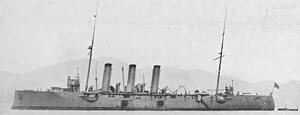Niitaka-class cruiser
 Niitaka in 1922
| |
| Class overview | |
|---|---|
| Builders | list error: <br /> list (help) Yokosuka Naval Arsenal (Niitaka) Kure Naval Arsenal (Tsushima) |
| Operators | |
| Built | 1901–1904 |
| In commission | 1904–1936 |
| Completed | 2 |
| Lost | 1 |
| General characteristics | |
| Type | Protected cruiser |
| Displacement | 3,366 long tons (3,420 t) |
| Length | 102 m (334 ft 8 in) w/l |
| Beam | 13.44 m (44 ft 1 in) |
| Draft | 4.92 m (16 ft 2 in) |
| Propulsion | 2-shaft VTE reciprocating engines; 16 boilers; 9,500 hp (7,100 kW) |
| Speed | 20 knots (23 mph; 37 km/h) |
| Complement | 287-320 |
| Armament | list error: <br /> list (help) • 6 × 152 mm (6 in) rapid-fire guns • 10 × 10-pounder rapid-fire guns • 4 × 47 mm (2 in) guns |
| Armor | list error: <br /> list (help) Deck: 76 mm (3 in) Conning tower: 100 mm (4 in) |
The two Niitaka class cruisers (新高型防護巡洋艦, Niitaka-gata bōgōjunyōkan) were protected cruisers operated by the Imperial Japanese Navy. They participated in numerous actions during the Russo-Japanese War and in World War I.
Background
The Niitaka class was the second cruiser class built to a completely Japanese design and was ordered as part of the 2nd Emergency Fleet Replenishment Program, with a budget driven by the First Sino-Japanese War. These small cruisers were intended for high speed reconnaissance. The lead ship Niitaka was built at the Yokosuka Naval Arsenal, Yokosuka, Kanagawa, which already had considerable experiencing in building small cruisers. Its sister ship, the Tsushima, was built at the new Kure Naval Arsenal, at Kure, Hiroshima and took considerably longer to complete.
Design

In terms of design, the Niitaka class was very conservative in layout and similar to, but somewhat larger and the earlier Japanese-designed Suma. The increased displacement, heavier armor and lower center of gravity resulted in a more seaworthy and powerful vessel than the Suma, and enabled the Tsushima to outclass many other contemporary protected cruisers.
In terms of armament, it is noteworthy that the Niitaka class cruisers were not equipped with torpedoes. Observing problems experienced by the United States Navy during the Spanish American War with torpedo reliability and the dangers of sympathetic detonation, it was decided not to use this weapon on the new cruisers. The main guns were standardized to the 152 mm standard.
The Niitaka-class cruisers were fitted with 16 Niclausse boilers, a great improvement on the locomotive boilers of the Suma.
Ships in class
Two Niitaka class cruisers were built. Both were lost before the start of World War II.
Ordered in 1897, launched 15 November 1902, and completed 27 January 1904, the Niitaka played a major role in the Russo-Japanese War. During World War I, the Niitaka participated at the Battle of Tsingtao and was subsequently assigned to patrol of shipping lanes in Southeast Asia, and in the Indian Ocean from its base at Cape Town. After the war, it served during Japan's Siberian Intervention. It was lost after running aground in a typhoon on 26 August 1923 on the coast of Sakhalin.

Ordered in 1897, launched 15 December 1902, and completed 14 February 1904, the Takachiho participated in the closing stages of the Russo-Japanese War. In World War I, the Tsushima played an active role in the Battle of Tsingtao and pursuit of the German East Asia Squadron. It was subsequently assigned to Cape Town, where it assisted its sister ship Niitaka in patrol of shipping lanes in the Indian Ocean. It subsequently was used in the Siberian Intervention. The Tsushima was struck from the Navy list in 1936 and expended as a torpedo target in 1944.
See also
![]() Media related to Niitaka class protected cruisers at Wikimedia Commons
Media related to Niitaka class protected cruisers at Wikimedia Commons
References
- Evans, David. Kaigun: Strategy, Tactics, and Technology in the Imperial Japanese Navy, 1887-1941. US Naval Institute Press (1979). ISBN 0870211927
- Howarth, Stephen. The Fighting Ships of the Rising Sun: The Drama of the Imperial Japanese Navy, 1895-1945. Atheneum; (1983) ISBN 0689114028
- Jane, Fred T. The Imperial Japanese Navy. Thacker, Spink & Co (1904) ASIN: B00085LCZ4
- Jentsura, Hansgeorg. Warships of the Imperial Japanese Navy, 1869-1945. Naval Institute Press (1976). ISBN 087021893X
- Schencking, J. Charles. Making Waves: Politics, Propaganda, And The Emergence Of The Imperial Japanese Navy, 1868-1922. Stanford University Press (2005). ISBN 0804749779
